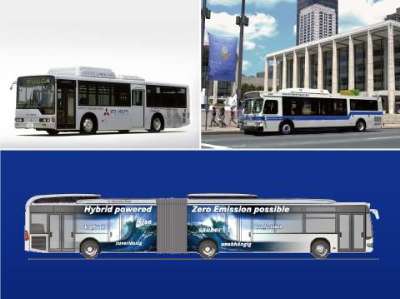|
| |||||
|
Mercedes-Benz Citaro Bus with Diesel-Electric Hybrid Drive Technology Announced
28th May, 2007 | ||||
|
DaimlerChrysler will unveil the first prototype of the diesel-electric hybrid Mercedes-Benz Citaro bus to the general public in the course of this year, the company announced at the occasion of the UITP world congress for public transportation in Helsinki, Finland. This prototype embodies highly sophisticated diesel-electric series hybrid technology which will allow emission-free operation in battery-only mode. The system will be installed in a Citaro G articulated bus. This configuration is currently unique. Following the unveiling of the prototype in the second half of 2007, pilot operation will begin early next year. Series production is scheduled for 2009. Andreas Renschler, the DaimlerChrysler Board of Management Member responsible for the Truck Group and Buses: “With diesel-electric hybrid vehicles from Orion in North America, Mercedes-Benz in Europe and Mitsubishi Fuso in Asia, DaimlerChrysler does not only have the longest, but also the most extensive experience with alternative drive systems for commercial vehicles. Therefore the new hybrid drive Citaro is an important step towards cost efficient and zero-emission driving.” Renschler emphasised, however, that the complex hybrid technology still requires start-up financing even though it supplies up to 30% fuel efficiency: “In order to make these technologies, that are up to one third more expensive than conventional drivetrain concepts, profitable for both customers and manufacturers, we need political and public support, e.g. by subsidies or public-private partnerships.” Rather than providing continuous driving power, the diesel engine in the Citaro series hybrid operates as a generator to produce electrical power as and when required. The electrical power is stored in maintenance-free lithium-ion batteries mounted on the roof of the Citaro. They are charged not only by the diesel generator but also by energy recuperation from braking. The actual drive power to the wheels of the Citaro hybrid is provided by four electric wheel hub motors on the centre and rear axles of the vehicle. The total wheel hub motor output of 320 kW is ample for an articulated bus even under strenuous operating conditions. When drawing into, standing at and accelerating away from bus stops, the hybrid bus can operate in electric-only mode, which is not only virtually emission-free but also much quieter. A big advantage of the clever series hybrid technology used in the Citaro is downsizing: instead of the large 12-litre six-in-line engine normally used in the articulated model, the hybrid bus is fitted with a compact unit with a displacement of 4.8 litres. This reduces the weight of the engine from approximately 1,000 kg to approximately 450 kg. Since the diesel engine of the Citaro hybrid does not drive the vehicle directly, it is not required to produce peak outputs and is therefore able to operate very economically and with low environmental impact over a narrow rpm range at or close to its peak efficiency. The torque curve of the hybrid-bus engine is therefore tailored to frequent steady-state operation, for optimal emissions performance and fuel efficiency. The hybrid-drive Citaro is able to dispense with a conventional automatic transmission. This results in improved efficiency and weight savings. The downsizing of the drivetrain components means that the weight penalty of the Citaro hybrid bus over a conventional diesel-powered articulated bus is only around one tonne. A close look at the hybrid-drive Citaro reveals it to be a logical step on the way to a fuel-cell-powered urban regular-service bus of the future. For example, the hybrid-drive Citaro already features a suitable electric drive unit, along with an energy store in the form of batteries. In principle, the diesel engine would simply need to be replaced by fuel cells. These are relatively minor changes from the design and manufacturing point of view, but they would allow the bus to operate with virtually zero emissions in urban areas. This Zero-Emission Vehicle would emit no particulates, nitrogen oxides or CO2, and would also be very quiet in operation. DaimlerChrysler has more extensive, and longer, experience with hybrid buses than any other manufacturer in the world. Daimler-Benz AG presented the world's very first hybrid bus at the Frankfurt Motor Show in 1969. It was based on an eleven-metre urban regular-service version of the Mercedes-Benz OE 302. A fleet of three Mercedes-Benz Citaro Fuel Cell hydrogen powered buses currently servicing normal bus routes throughout the city of Perth in Western Australia have each celebrated 3,600 hours of operation. These buses have been operating in Perth as part of an international trial of hydrogen Fuel Cell technology since September 2004. Our story on the Perth trial is here. The Orion-brand buses built by DaimlerChrysler's North American bus subsidiary are already well past the trial stage. Since 2003, Orion has won contracts to supply numerous US and Canadian cities, from New York to San Francisco, with a total of some 1,500 Orion VII Hybrid low--floor urban regular-service buses, around 1,000 of which are already on the road. On top of this, there are also options on a further 525 vehicles. This makes Orion the world market leader in hybrid buses. The Orion VII Hybrid was developed by Orion in association with US partners BAE Systems and is a series hybrid vehicle. The diesel engine operates continuously, powering a generator which in turn powers the electric motor. No provision has been made for recharging the Orion from an electric power outlet. Tests revealed that the Orion is approximately 25% more fuel-efficient than a diesel powered competitor vehicle. Likewise active in the field of series hybrid-drive urban buses is DaimlerChrysler's Japanese commercial vehicle subsidiary Fuso, with the low-floor Aero-Star model. A number of these first standard-production Japanese hybrid buses have already gone into regular-service operation. Testing was already under way in Japan by 2002. | |||||
ABN 47106248033 |
 |
All rights reserved. |
